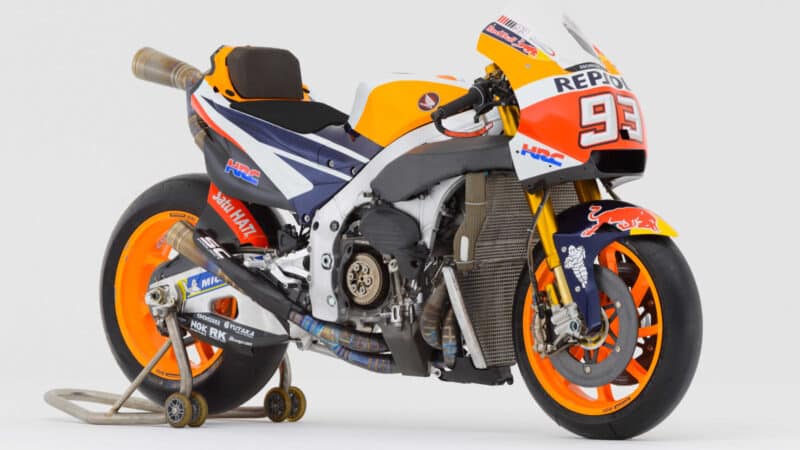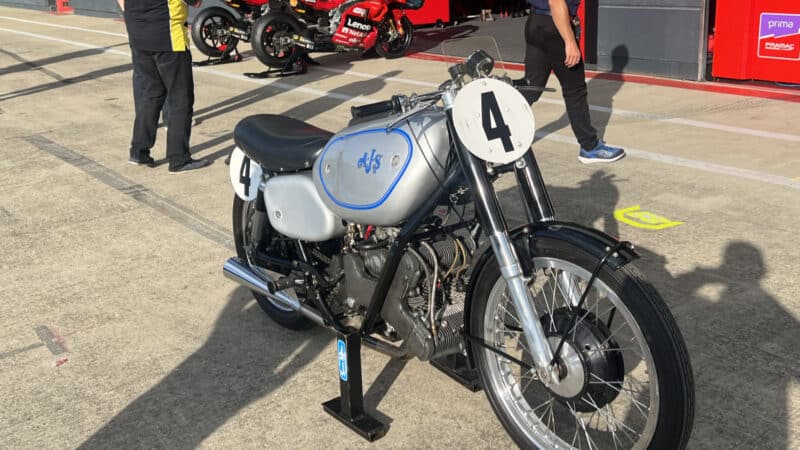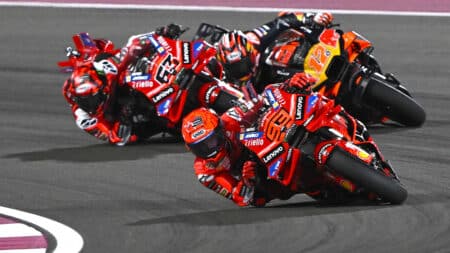However, Michelin’s new-for-2024 rear slick cut times by up to a second and, if Michelin introduces its new front slick next season, lap times will fall again.
Therefore there’s a real chance that this latest rules change won’t meet its intentions — slowing the bikes down. If that happens, perhaps those in charge will finally understand that the surest way to contain performance is via reducing grip.
The MotoGP rules timeline 2007 to 2027
2007
- Engine capacity: 800cc, reduced from 990cc. Two-strokes banned for the first time. Unlimited number of cylinders allowed. Minimum weights: two cylinders or fewer 133kg, three cylinders, 140.5kg, four cylinders 148kg, five cylinders 155.5kg, 6 cylinders 163kg.
- Fuel: 21 litres (down from 22 litres).
- Tyre allocation: 18 front slicks, 22 rear slicks.
- Practice/qualifying: FP1 60 minutes/FP2 60m/FP3 60m/QP 60m.
- Winter testing limit: 22 days per rider.
2009
- Single-make tyre rule introduced: Bridgestone tyres.
- Tyre allocation: 9 front slicks, 12 rear slicks.
- Winter testing limit: 12 days per rider.
2010
- Four-cylinder engines only, minimum weight: 150kg.
- Tyre allocation: 8 fronts, 10 rears.
- Engine durability rules introduced. Six engines per rider, nine for those manufacturers that have won fewer than two dry races in the previous two years. Engines sealed at start of season, no internal upgrades allowed.
- Wheel rims: Number of different wheel rims used by manufacturers limited for first time: only two front wheel widths and one rear wheel width per manufacturer. Max rim sizes: front 4in, rear 6.25in.
- Electronically controlled suspension, ride-height adjusters and steering dampers banned.
- Global positioning system software banned.
- Practice/qualifying: FP1 60m/FP2 60m/QP 60m.
- Annual testing limit: 12 days per rider.
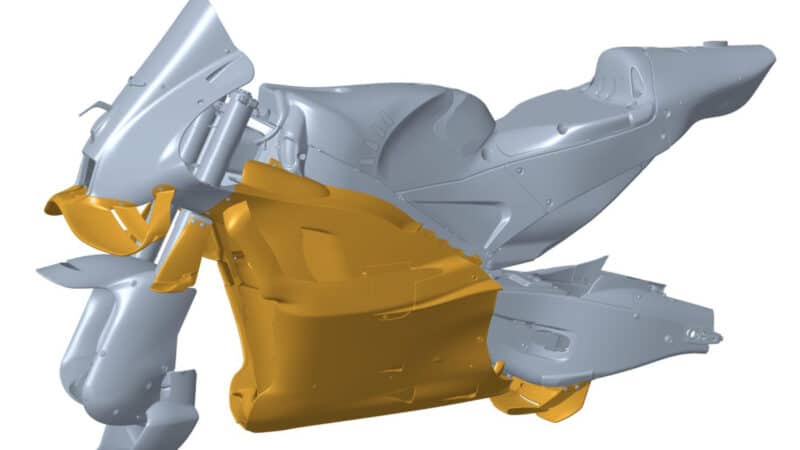
Downforce aerodynamics are now subject to regulations and will be trimmed from 2027. This is Aprilia’s midseason upgrade from last year
Aprilia
2011
- Gear ratios limited for the first time: only two ratios for each gear and two primary-drive gears.
- Practice/qualifying reduced: FP1 45m/FP2 45m/FP3 45m/QP 60m.
2012
- Engine capacity: 1000cc, four cylinders only, maximum bore 81mm.
- Different categories within the same championship introduced for the first time. Claiming Rule Teams are privateer teams that can’t afford full-spec MotoGP bikes, so they’ use MotoGP bikes powered by cheaper superbike engines. Basically, CRTs are there to make the grid look less empty.
- Manufacturers (not other CRTs) are allowed to buy engines from CRT teams for 20,000 Euros, to discourage CRTs from spending too much money and getting too close to the factory bikes. (This was never going to happen and no CRT engines were claimed).
- Fuel capacity: 21 litres, 24 litres (CRT).
- Tyre allocation: 9 front slicks, 10 rear slicks.
- Engine durability: 6, 12 (CRT).
- Annual testing limit: 240 tyres per rider.
2013
- Minimum weight: 160kg.
- Tyre allocation: 9 front slicks, 11 rear slicks.
- Engine allocation: 5, 12 (CRT).
- Practice/qualifying: FP1 45m/FP2 45m/FP3 45m/FP4 30m/QP 2 x 15m.
2014
- A new sub-category, Open, is introduced to replace the CRT category. Open bikes are full prototypes but not latest-spec factory bikes. They are leased or sold to teams.
- Fuel capacity: 20 litres, 24 (Open).
- Engine durability: 5, 12 (Open).
- MotoGP bikes must use official MotoGP hardware.
- Open bikes must use official MotoGP hardware/software.
- Annual testing limit: 120 tyres per rider.
2015
- Full concession rules are introduced for the first time, to help poorer-performing manufacturers catch up.
- Concessions include more engines and engine upgrades, more testing, more fuel, stickier tyres and more wild card entries. They are available to brands that didn’t win a dry race in 2013 or 2014, or are entering MotoGP for the first time or returning for the first time since 2013.
- Minimum weight: 158kg.
- Tyre allocation: 10 front slicks, 11 rear slicks.
- Annual testing limit: 15 days per rider.
- Engine durability: 5, 12 (Open and concessions).
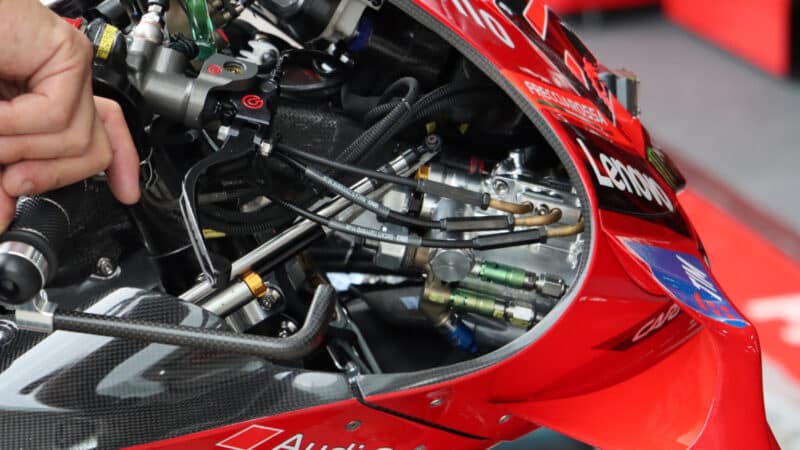
Ride-height adjuster plumbing in the fairing nose of a 2025 Ducati. All such devices will be banned from 2027
Mat Oxley
2016
- One MotoGP class (no sub-classes).
- Minimum weight: 157kg.
- Fuel capacity: 22 litres.
- New single-make tyre supplier: Michelin.
- Tyre allocation: 10 front slicks, 12 rear slicks.
- Engine durability: 7.
- Electronics: All bikes must use official MotoGP hardware/software.
- Annual testing limit: 14 days per rider.
2017
- Aerodynamics homologation – only one aero update per rider during season.
- Aero regs: windscreen width limited to 300mm, length 370mm.
- Advisory minimum front slick tyre pressure 2.0 bar, rear 1.8.
- TPMS (tyre pressure monitoring systems) mandatory.
- Dynamic tyre-pressure adjusters banned.
2019
- All bikes must use official MotoGP IMU.
- New restrictions to aero bodies.
2020
- Emergency changes to technical rules due to Covid-19 pandemic: engine specs are frozen for 2020 and 2021 and only one aero update during these two seasons, for non-concessions and concessions manufacturers.
2022
- Tyre pressures monitored by Race Direction and pressure data shared among teams – the first step towards enforcing minimum-pressure rules, which can’t happen until all teams use the same brand of pressure sensor. Why is the rule being enforced? Because some teams know that others are running under the limit and gaining an advantage.
- Minimum front slick tyre pressure 1.9 bar (reduced from 2.0 bar), rear 1.7
2023
- Minimum front slick tyre pressure 1.88 bar.
- Common TPMS (tyre pressure management system) must be used, which allows the pressure rule to be enforced. Tyre pressure rule was first fully enforced at August’s Austrian GP: first offence, warning only; second offence, three-second penalty, third offence, six seconds, fourth offence, nine seconds.
- Sprint races introduced – 12-litre fuel capacity.

Seat downforce aero on a 2024 Honda RC213V. Seat aero isn’t restricted like other aero bodies, but from 2027 it will be included in aero homologation rules
Mat Oxley
2024
- New concessions rules introduced, specifically to help Honda and Yamaha catch Ducati.
- Manufacturers are split into four groups, according to the percentage of constructor points scored: A is 85% plus, B is 60=85%, C is 35-60% and D is up to 35%.
- At the top, A group manufacturers get 170 tyres for testing, no testing with full-time MotoGP riders, no wild cards, seven or eight (depending on number of GPs) sealed engines and one aero upgrades. At the bottom, D group manufacturers get 260 tyres, testing with all their riders, six wild cards, nine or ten engines, with no limit on upgrades, and two aero upgrades.
- Minimum front slick tyre pressure 1.80 bar.
- Tyre pressure penalty increased to immediate disqualification, soon reduced to a 16-second penalty.
- All fuel to be 40% of non-fossil origin.
2025/2026
- Engine freeze is increased to two years – 2025 and 2026 – to allow manufacturers to focus on 850cc engine development. D group concession manufacturers can continue developing their 1000cc engines.
2027
- Engine capacity: 850cc, four cylinders only, maximum bore 75mm.
- Engine allocation: 6 (up to 20 GPs), 7 (over 20 GPs). Concession manufacturers get 2 additional engines, unsealed.
- All GPS rider data will be available to all teams.
- Gearbox ratios: 16, primary drive 4.
- Minimum weight: 153kg.
- No ride-height devices and holeshot devices permitted.
- Fuel capacity: 20 litres (11 for sprints).
- Aero body width 550mm (down from 600mm). Maximum height of rear ends of motorcycles 1150mm (down from 1250mm). Front of fairing noses moved back 50mm.
- Seat aero homologated as per other aero surfaces (Previously seat aero was exempt from homologation).
- All fuel and oil to be of non-fossil origin.
